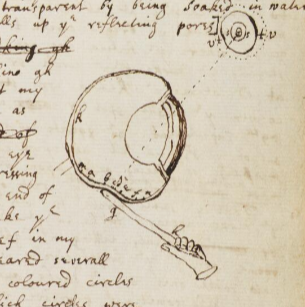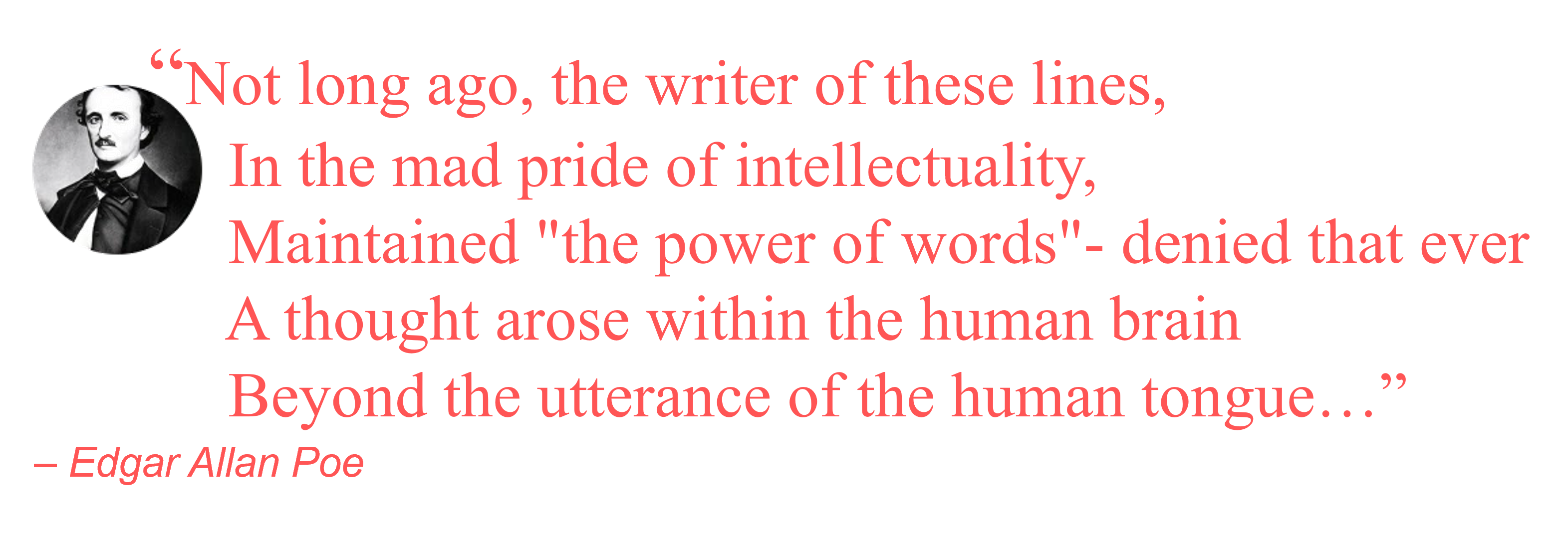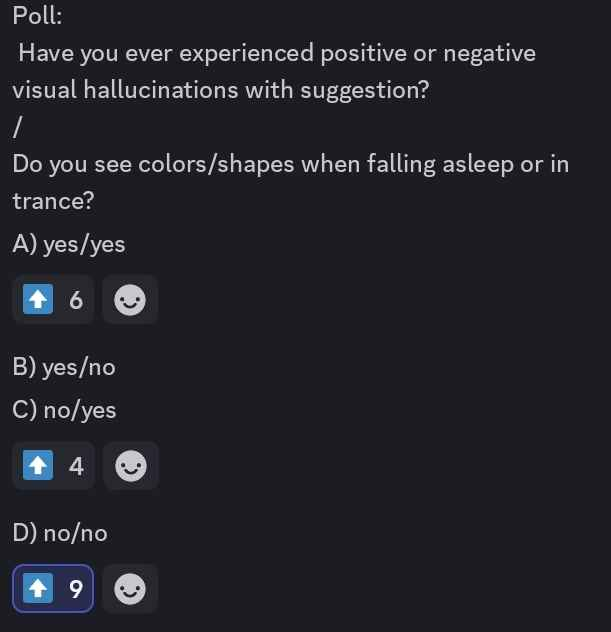3. Something about Phosphenes
There are sensations which do not correspond to anything outside the body. In so far as they imitate the qualities and forms of external things, they thereby often give rise to illusions, phantoms, or appearances with no corresponding reality. These can be referred to as subjective sensory phenomena.
— Purknyě (1819/1823a, pp. 3–4)
The Three Strands of Light
Do you remember ever rubbing your eyes and seeing patterns or blobs of light, even though your eyes were closed? Perhaps you might remember seeing them as you were slipping into sleep, dancing on the back of your eyelids, when you were a child and the structure of the world was new1 They happen to adults too, in these liminal, hypnagogic states. . This seeing light without light has been remarked upon through the centuries by the likes of Purknyě, Isaac Newton, and others. Back then, science was young and poked itself in the eye out of sheer curiosity and self-experimentation. Today, they are called “Phosphenes”2 Phosphene: (mid 19th century) from French phosphène, from Greek phōs “light” + phainein “to show”. .

“I took a bodkin (knitting needle) and put it betwixt my eye and bone as neare to backside of my eye as I could.”
— Newton’s Notebook; he saw coloured circles in trying to alter the curvature of the eye and notice the change in vision.
Pressure phosphenes, like the rings that Newton saw, are one of the methods recommended by Win Wenger to jumpstart visual imagination in his image streaming methods for people who cannot visualize3 A writer and teacher in the field of skill acquisition for creativity, learning, and visual imagination, who himself had trouble with visual imagination, and developed image streaming based methods to learn to visualize. . I, myself, came to know of this set of techniques after my ganzfeld experiment through AphantasiaMeow, who was at that point collaborating with Dr. Reshanne Reeder, and claimed to be able to help people with aphantasia to learn to visualize4 Aphantasia is the absence of mental imagery, coined by Adam Zeman, et al. in 2015, described by Galton in 1880. . His methods can be found here. The other method Wenger suggested was using afterimage illusions. It happens when you stare at an image or a light for a while and the image persists even when you look away or close your eyes5 Purknyě describes them too at the dawn of science: “The vividness of the afterimage varies depending on conditions. It is particularly intense when mental activity is heightened—such as after consuming stimulating beverages or narcotic substances—or when there is a special interest in the object. In states of feverish excitement or heightened cerebral activity, it can sometimes become so pronounced that it seems almost objectively indestructible. Conversely, dazzling images persist under nervous conditions, linger longer during states of debility, and vanish more quickly when the body is energized and blood flow is robust.” . It does not quite fall under the traditional definition of phosphenes but it is light without light. This method, however, is not entirely new and traces back millennia to the practice of fire kasina in Tibet and India. It is not uncontroversial in its practice. Often, the internet reports hearsay of practitioners warning against kasina meditation, but the one firsthand report of what sounds like short-term psychosis is recounted by Daniel Ingram here with uncontrolled visual hallucinations. Eventually, his experience settles under his volitional control, and he learns to control these visual projections. The host of the page likens them to freewheeling hallucinations, which they define as hallucinations that (a) you know are not real, (b) you have agentic control over.
This all sounds very much like what AphantasiaMeow has coined “prophantasia”, which after the longest wait, has made its way to the academic literature through his collaboration with Dr. Reeder6 Reeder, R. R., Azañón, E., Pounder, Z., & Figueroa, A. (2024). Individual variability in mental imagery vividness does not predict perceptual interference with imagery: A replication study of Cui et al., 2007. . Prophantasia occurs naturally in some people. And prophants are often surprised to find out that others do not imagine projections of visual precepts in real space. This is reminiscent of aphants being surprised that others do visualize images in their mind’s eye.
A third way to induce light without light is to take away the structure of the world with sensory deprivation so that the mind might impose its own structure in trying to find it — as in my experiment with the Ganzfeld Effect. My experiment was, all in all, a faster and gentler intervention than these with more pronounced effects (at least the desired ones), and I think we benefited greatly by the highly visual imagination of my then partner and our history and skill at playing with our experience7 We often joked she had a picture brain like Nabokov: 
…while I had a word brain like Poe : . Perhaps you already see the three strands I am spinning into this thread of yarn.
. Perhaps you already see the three strands I am spinning into this thread of yarn.
The common thread that links phenomena of this phenomenal ink that can paint pictures for our mind to see out of light without light seems to be:
Hypothesis and Testing
This allows a testable hypothesis: If positive hypnotic hallucination follows similar mechanisms, people who have managed that will be disproportionately likely to experience phosphenes in naturalistic conditions, like falling asleep or going into certain kinds of trance. This first came to mind when an acquaintance posted about having had success with a subject who had been able to negatively hallucinate a hand. Now, sometimes negative hallucination can be better explained as inattentional or change blindness, but from this account, it clearly wasn’t the case that they were simply ignoring their hand8 You are negatively hallucinating your nose right now. Or at least you haven’t been paying attention to it. Now that you notice it, can you unnotice it? .
This was an opportunity for an epistemic spot check, and I asked him to ask her if she saw colors or patterns when going to sleep or into trance. He was puzzled by the request but did so, and she answered with an emphatic yes — to his surprise. This bolstered my suspicion, and I followed it up with an informal public poll on a Discord server where I thought I would get a decent amount of subjects to respond to see if there was indeed a signal here.

Of the 19 people who responded, including your author, 10 reported having seen phosphenes and of those, 6 reported having seen hallucinations. This result further motivated me to do a poll in a similar subreddit for confirmation. The signal was weaker, but still pretty strong, in this less filtered sample.
Survey Results (n=89)
| Experience | Count | Percentage |
|---|---|---|
| Yes Hallucination, Yes Phosphenes | 11 | 12.4% |
| Yes Hallucination, No Phosphenes | 2 | 2.2% |
| No Hallucination, Yes Phosphenes | 27 | 30.3% |
| No Hallucination, No Phosphenes | 49 | 55.1% |
Here are statistical analyses for the curious:
-
Overall Experiences:
- 14.6% reported experiencing hallucinations
- 42.7% reported experiencing phosphenes
- 55.1% reported neither hallucinations nor phosphenes
-
Statistical Analysis:
- Chi-square test for independence:
- χ² = 10.934, df = 1, p-value = 0.001** (significant at p < 0.0025)
- Odds ratio: 9.98 , 95% CI [2.06, 48.37]
- Chi-square test for independence:
-
Conclusions:
- There is a statistically significant association in this sample between experiencing hallucinations and phosphenes (p < 0.0025).
- The odds of experiencing phosphenes are about ~10 times higher for those who have experienced hallucinations compared to those who haven’t, though there is substantial uncertainty in this estimate as indicated by the wide confidence interval.
Interpretations
There are lies, there are damned lies and then there are statistics. Numbers numb without interpretation, and there are difficulties here in interpretation despite the strong signal they imply. As the discrepancy in the smaller “server poll” & the larger “subreddit poll” showed, there is a significant sampling bias here due to selection effects in online communities and the power law of participation. Most people lurk, fewer participate in subreddit polls, even fewer in Discord polls, and given selection pressures, it might be that the people who are more likely to say yes are also more likely to participate in polls. You cannot, therefore, really generalize these results to the general population, but I think the signal is sound enough to warrant further thought, explanation and experimentation9 Send me ideas! Or tell me if you tried it! . Scientific models of visual hallucinations are in development and testing out these ideas more directly and rigorously should be possible. This can be either correlational, as in my surveys above but with better samples and better methods, or directly as skill training interventions using things like image streaming, afterimage illusions, and the ganzfeld intervention.
To go even further, beyond the spontaneous phosphenes of liminal and altered states, I think there is good reason to believe that phosphenes can be induced directly with suggestion. There was a paper that purported to induce “synesthesia” through cross-modal activation - basically arguing that sounds could trigger visual experiences through how our senses interact. They put people in a dark room for 5 minutes with random beeping sounds and a button to press when they saw something. They ran three studies testing different conditions - regular beeps, louder beeps at 70 dB, and beeps paired with a visualization task. Looking at the data, out of 77 total participants, 57% reported seeing something at least once. In the visualization task group (n=25), 72% of people said they saw something. However, I believe they were mostly looking at expectancy effects due to implied and tacit suggestions of the experimental context10 These are formally called “demand characteristics”. . These people were not just sitting in a dark room with a speaker playing a beeping sound at random. They were told to expect to see something. There is another paper that all but confirms this. You see, phosphenes are a thing that happens when people are subjected to extreme magnetic and electric fields during medical imaging. This was a study written in German that found if you told people that they were going to see phosphenes as they turned the machine on — but they did not turn the machine on and simply made a lot of noise — 90% of these people saw phosphenes (n=28).
The above two studies seem to throw a question mark on my surveys. Why is there a discrepancy in the numbers? 90% in the German study, 72% in the (pseudo-)synesthesia study, and 43% in my survey. There are important differences between the conditions here, the German study had each person undergo 20 trials each, the sound was no doubt louder than 70dB and the demands were stronger. They were supposed to experience a phenomena known to be a concrete neurophysiological thing, strong electric and magnetic fields do, in fact, induce phosphenes. The synesthesia paper on the other hand explicitly asked people to press a button when they saw something, presupposing that they would see something, and even though they did not explicitly set out to test different demand characteristics, they functionally ended up doing so. And I think that there is enough evidence in the literature to suggest that phosphenes can be induced with suggestion, especially if we do not take the literature at face value. So, what about the poll? It is possible (and in my opinion, likely) that more people would experience phosphenes when falling asleep or in trance if that was a common suggestion but this does happen spontaneously for a lot of people even without suggestions in hypnagogic states. This experience, however, was foreign to me and I was surprised to find a substantial number of subjects to spontaneously experience this through these surveys and conversations that led me to them.
Self-Experimentation
This then also led to my own personal self-experimentation with Kasina and phosphenes about a year ago. I started by playing around with staring at bright lights and observing their afterimages11 Pressure phosphenes do not happen for me for some reason. . I did not expect much out of it but soon the length of the images started getting longer and they would sometimes start to morph and move in unpredictable ways. This was enough to turn me off the practice. I did not have the time or inclination for a Daniel Ingram-esque breakdown in the structure of my reality, and I had genetic risk factors for schizophrenia12 Ingram has since published a paper on the topic, likening it to psychedelic and near-death experiences, and calling kasina hallucinations “sometimes controllable”. Woollacott, M., Riddle, J., Hermansson, N., Sacchet, M. D., & Ingram, D. M. (2024). Fire Kasina advanced meditation produces experiences comparable to psychedelic and near-death experiences: A pilot study. EXPLORE, 20(6), 103056. .
It took a bit of time to start playing around with it again. Meanwhile, the response faded and I did not really pay much mind to phosphenes. But eventually, on a sleepless night, my mind wandered to the survey and the studies and I started staring at the darkness behind my eyelids. It was a while before I noticed anything. The shapes and colors were not remarkable when I first noticed them. But with time, they got more complex; sometimes they would fill the entire field of vision with colors, and my eyes would want to open. My eyelids fluttered for some minutes and eventually calmed down, and sleep came to me. This has proven a reliable way for me to fall asleep on nights when I am struggling. They never start immediately even these days but I will notice blobs & texture change within a minute or two. They will get more complex if I let them without falling asleep completely. They are like drabber and less interesting cousins of the closed-eye hallucinations I get on psilocybin.
And, similar to the visuals in shroom trips, I cannot agentically control them by a direct act of will. What does help shape them, however, is expecting to discover the thing I have decided upon and waiting for it to reveal itself, implying top-down control over these percepts was possible and could get better with practice. This was in line with how visual hallucinations would work for my ex, post-Ganzfeld, where an attitude or instruction to discover a construct would work better than directly suggesting the construct. To give a personal example from last Sunday, I had woken up briefly that night and was going back to sleep — the lecture that I was listening to to fall asleep was proving to be entirely too entertaining to be conducive to sleep and I decided to turn it off and see what images I could conjure up behind my eyelids on my way to sleep. The visuals started quickly, and within minutes I was seeing a black ink lattice of masks tiled together. I thought it would be amusing to see if I could suggest a penguin to appear. It took a while, and it did not look like Pingu, who I was thinking of. Instead, it was a large shadow of a penguin on the lattice of masks. It had a tuft of mohawk-like feathers on its head, and it was holding a suitcase. The shadow lasted for a moment and faded, and it was just back to that screen-saver-like lattice of masks till I fell asleep.
So there is something about phosphenes. We can likely see them without any sort of trance, and inducing them might be the first step towards developing prophantasia and controllable visual hallucinations in hypnosis-adjacent contexts without any profound alteration in state. But I think there is something about state too13 Which might come as a surprise to some who know me in the hypnosis community as one of the non-state people. . There is also more to be said about the sense-making of these illusory precepts, visual hallucinations on the basis of non-state and modern scientific ideas, and how they differ from synesthesia. But that is an essay for another time.
Misc. Links for readers and future Weavers:
- An alternative translation of Purknyě’s work: https://schwitzsplintersunderblog.blogspot.com/2006/09/purkinje-translation.html
- Amusing talk page on the Wikipedia article about closed-eye hallucinations: https://en.wikipedia.org/wiki/Talk:Closed-eye_hallucination
